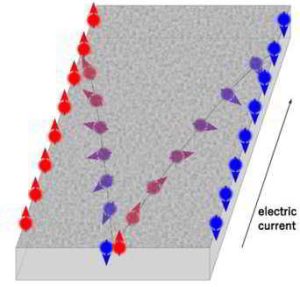Osaka University Research Fuels Future of Data Storage: Predicting Spin Accumulation for Faster, Greener Memory
Advancement is significant for developing next-gen magnetic memory devices.
This is a Press Release edited by StorageNewsletter.com on July 29, 2025 at 2:53 pmFrom SANKEN/University of Osaka
Researchers from SANKEN (The Institute of Scientific and Industrial Research) at The University of Osaka have developed a new program, ‘postw90-spin,’ that enables high-precision calculations of a novel performance indicator for the spin Hall effect, a phenomenon crucial for developing energy-efficient and high-speed next-gen magnetic memory devices.

This breakthrough addresses a long-standing challenge in spintronics research by providing a definitive measure of the spin Hall effect, overcoming ambiguities associated with traditional metrics.
The spin Hall effect, where many researchers recognize an electric field generates a perpendicular spin current, is key to spintronic devices. Previously, the spin Hall conductivity was used as a performance indicator. However, this metric is affected by how the spin current is defined, leading to inconsistencies.
Spins accumulate at both edges of sample owing to spin Hall effect. Although spin current is expected to flow inside the sample, it has not been observed yet.
(License:Original content / Usage restriction: Credit must be given to the creator. / Credit: Atsuo Shitade)
The new program calculates the spin accumulation coefficient, which quantifies the spin accumulation at the edges of a material due to the spin Hall effect. This coefficient is directly measurable and unaffected by ambiguities in defining spin current, offering a more reliable performance prediction for spintronic materials. The program uses first-principles calculations, relying on fundamental quantum mechanics, allowing accurate predictions for real materials.
This advancement is significant for developing next-gen magnetic memory devices. Identifying materials with large spin Hall effects is crucial for creating energy-saving, high-speed, and durable non-volatile memory. By accurately calculating the spin accumulation coefficient, researchers can now effectively screen and identify promising materials for these applications, accelerating the development of advanced spintronic technologies.
“The ambiguity in defining spin current has been a problem that researchers in the field of the spin Hall effect have been aware of, but have turned a blind eye to because other methods are difficult,” says Dr. Atsuo Shitade, lead researcher. “We believe that providing a definite answer to this problem and establishing a method for predicting real materials will greatly advance the microscopic understanding of the spin Hall effect and serve as a bridge between spintronics experiments and theory.”
Article: Wannier interpolation of spin accumulation coefficient
npj spintronics has published an article written by Atsuo Shitade, and Emi Minamitani, Institute of Scientific and Industrial Research, The University of Osaka, Ibaraki, Osaka, Japan
Abstract: “The spin Hall (SH) effect is widely understood as a phenomenon in which spin current flows perpendicular to an electric field. In the presence of a spin-orbit coupling, however, spin current is ambiguous, and the SH conductivity depends on the definition of spin current. In this article, we develop an ab initio computational scheme for the spin accumulation coefficient, which characterizes the spin accumulation and would be an alternative indicator of the SH effect. The proposed method has been implemented into an open-source software Wannier90 and serves high-precision ab initio research on the SH effect.“















 Subscribe to our free daily newsletter
Subscribe to our free daily newsletter


